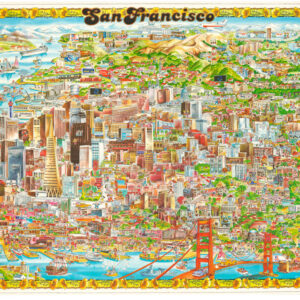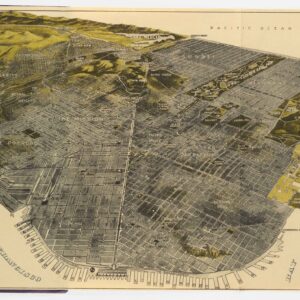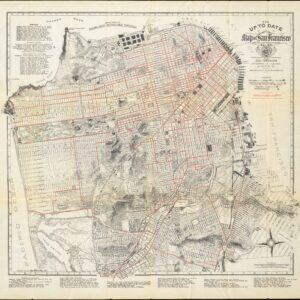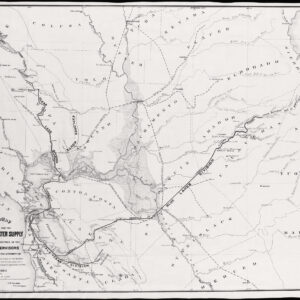Remarkable 1883 manuscript map of land grants in San Francisco.
Plat of the Pueblo Lands of San Francisco finally confirmed to the City of San Francisco. Surveyed under instructions from the U.S. Surveyor General by F. von Leicht, U.S. Dep. Surv. in December 1883 Containing 17754 36/100 Acres.
Out of stock
Description
This is a manuscript plat map of San Francisco confirming the lands awarded to the city in the long-standing, multi-faceted dispute between grantees, squatters, the federal government, and the City and County of San Francisco.
In order to understand why this map was published in the 1880s, we attempt to describe the basic outlines of the complicated circumstances that led to a situation in which von Leicht was in effect making a resurvey of the pueblo lands more than 30 years after it had ceased to exist.
As part of the Treaty of Guadalupe Hildago and the conclusion of the Mexican-American War, the United States agreed to recognize all existing property rights. In Alta California, however, officials immediately ran in to difficulties, with claims spanning both the Spanish and Mexican period, poorly defined boundaries, and a class of early American settlers who had more or less acted independently in the final years of Mexican rule. That much of the land they claimed was covered by pre-existing Mexican grants did not hinder these American from asserting it as their own.
In order to sort out the mess of private claims, Congress passed the Act of March 3rd, 1851, which established a three person commission and procedures for evaluating claims. The most complicated claims involved the former pueblos of California, including the City of San Francisco, successor to the Pueblo of Yerba Buena. In fact, while the official claim of the city was presented to the board in 1852, the United States Circuit Court did not confirm the claim until 1865, with the Act of Congress granting the lands passing on March 8th, 1866. The confirmatory decree stated that: “The land of which confirmation is made is a tract situated within the county of San Francisco, and embracing so much of the extreme upper portion of the peninsula above ordinary high-water mark (as the same existed at the date of the conquest of the country, namely, the seventh of July, A. D. 1846), on which the city of San Francisco is situated, as will contain an are of four square leagues — said tract being bounded on the north and east by the bay of San Francisco; on the west by the Pacific Ocean; and on the south by a due east and west line.”
In 1867, the first survey to determine the boundaries of the land confirmed was commenced by Deputy United States Surveyor James T. Stratton. The survey was seemingly a straightforward affair to delineate the city claim to four square leagues of land, as originally guaranteed to every pueblo under Mexican law. The limits along the west coast were easily determined, as the shoreline of the Pacific maintained its natural line. But the north and east shorelines of San Francisco Bay were to become the subject of great controversy because it was unclear if extensive marsh lands east of the Presidio, and at Mission and Islais Creeks should be included in the surveyed land to be given to the city.
The main point of contention with Stratton’s methodology was that while he followed the high water mark of the Bay at normal shorelines, whenever he reached an estuary or creek, he followed the tide line inward, then crossed over and came back down. The city of San Francisco argued that Stratton should have instead carried the survey line directly across the mouths of estuaries, cutting off them off and thus giving more land to the city.
For reasons unclear, the Stratton survey sat in a Washington, D. C. office for over ten years before being confirmed in 1878. But then the Department of Interior set it aside and ordered a new survey to be conducted by Ferdinand von Leicht. As stated on the map, von Leicht completed his survey in December 1883, which was endorsed by the Commissioner of the General Land Office in May 1884. The patent was in this way issued on the von Leicht survey, which followed the shoreline of the Bay in the more favorable way to the city than had Stratton. This background also explains why most of the information on the map is found on the north and east sides of the peninsula, along the shoreline, and especially in estuaries and creeks.
The plat shows part of Rancho San Miguel; Rancho Rincon de las Salinas Portrero Viejo; the Presidio Military Reservation; the Charter Line of 1850; Point San Jose Military Reservation; and a number of early roads. There is a “Description of Lands included within the Exterior Boundaries of the Pueblo of San Francisco” at upper left, with a key showing 15 grants and tracts. A table at right gives precise description of boundaries of the Pueblo Lands.
Among the grants and tracts shown in the key are: The Presidio, Point San Jose Military Reservation, Two Lots in the City (confirmed to Jacob P. Leese et al May 29, 1857), Part of Rancho Rincon (confirmed to Jose Cornelio Bernal August 4th 1857), Part of Rancho Miguel (Jose de Jesus Noe December 4th 1856), Ojo de Agua Figueroa (Juana Briones Miranda et al. January 14th 1876), 2 tracts of land at Mission Dolores (Joseph C. Allemany, Archbishop April 4th 1857), Tract of Land at Mission Dolores (C.S. de Bernal et al, July 27th 1863), Lot in Mission Dolores (Francisco de Haro August 3rd 1863), Suerte en Dolores (heirs of Francisco Guerrero Palomares April 16th 1861), Fifty lots in Mission Dolores (Francisco de Haro May 10, 1861), Lot in Mission Dolores (Candelario Valencia July 31st 1882), Lot in Mission Dolores (Elizabeth de Zaldo July 31st 1882), Carmaritas (Ferdinand Vassault et al June 26th 1882). Areas in acres also shown, along with the grant locations.
Cartographer(s):
Ferdinand von Leicht was a U.S. government surveyor active in the second half of the 19th century.
Condition Description
Manuscript map in black and red ink with hand-coloring in outline on verso, which shows through faintly to the recto, evidently as intended. On drafting linen, folded. Some light foxing and wear at the folds.
References




